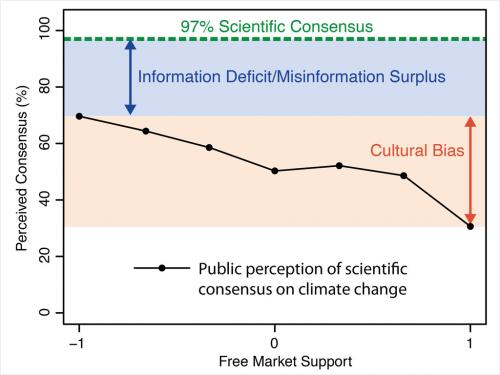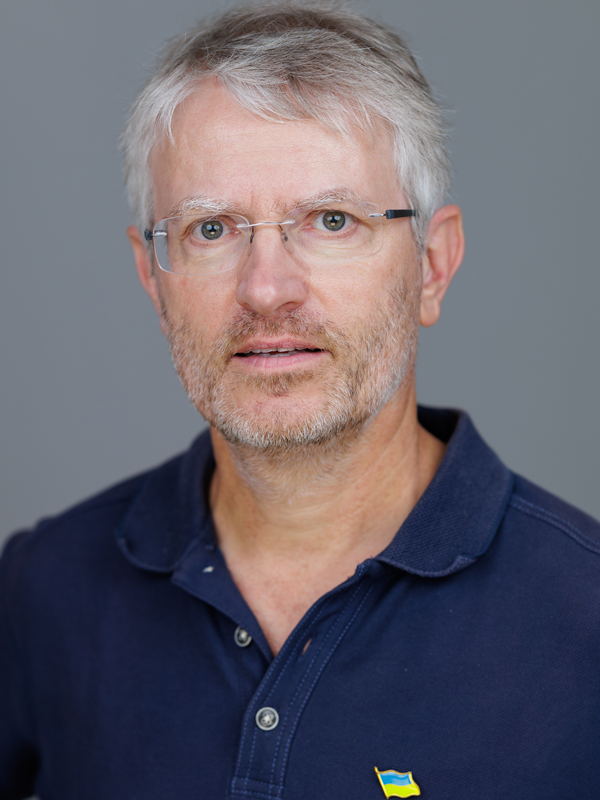Biography
Professional Links
Additional Information
The consensus gap
The Inter-Governmental Panel on Climate Change, specifically its Working Group I that evaluates climate change science, will present its Fifth Assessment Report end September 2013 ( http://www.climatechange2013.org/ ). At that time, a lot of media reporting will flood the airwaves, undoubtedly with much misinterpretation and cherry-picking of the report’s contents. While the report is unlikely going to contain much new information regarding the basics of planetary warming (greenhouse gases and greenhouse effect, ocean acidification, sea level rise, etc.), it is likely to convey a message of increasing risk under the current global business-as-usual increased fossil fuel use scenarios. It is therefore also to be expected that contrarian voices outside the field of science, particularly in the US, will continue their attacks on science and scientists – possibly with increased vigor. Social science research has shown (Fig. 1) that the public as a whole still perceives that there is little scientific consensus on human-caused global warming. The origins of this misperception probably lie in both (i) concerted media campaigns by US contrarian voices that began in the early 1990s, and which have led to widespread misinformation (“information deficit model”), fabrication of “doubt”, and associated discreditation of climate science and scientists, and (ii) the general public’s filtering of climate science information through cultural, faith-based, and political opinion lenses (“cultural cognition model”), leading to rejection of information for unrelated reasons.

While it cannot be our task as scientists to convince the unconvinced, or run a media campaign to reach a large number of the citizenry, we should feel obliged as scholars and are often mandated by federal law to reach out and communicate important findings to a broader public. As there are clear indications that
1. the public is misinformed about climate change and associated societal risks, and
2. the publication of IPCC’s 2013 WG I and 2014 WG II reports will create an educational opportunity,
we ought to explore a more proactive approach of public outreach during this school year.
Democracy requires an informed citizenry
We cannot presume any more that our scientific findings get translated into technical or societal progress by publication in scientific journals and popularization by a responsible and fact-based media landscape. While the latter is largely functional in Europe, the entertainment- and headline-focused, politicized, and largely polarized US media environment requires a much more active involvement of scientists to convey scientific knowledge accurately. Assessments have shown (e.g. here, here, or most recently here) that a better informed public on climate change is more likely to support measures to reduce greenhouse gas emissions, and rapid greenhouse gas emission reductions are needed to mitigate warming in the 21st century as climate science shows. What is causing this warming, how it will develop, what consequences this future development may have, and why this brings about a variety of societal risks, is conveyed by us in numerous classes at Texas A&M almost daily. As scholars, we rely for our teaching not only on the newest research, including our own, but also on the IPCC’s assessment reports. It seems fitting therefore, that we cease the opportunity of the publication of the newest reports this fall and spring semesters to reach out to the campus community and the public at large as a way to educate the current and future generation about what awaits us and how that matters.
While stepping out of the ivory tower is not for everyone, I advocate for a more proactive approach of scientists in informing the public about climate change; here, I propose to begin active outreach in the form of short presentations followed by question and answer sessions in public forums designed to provide first-hand information instead of media-based messaging.
Research Interests
UPDATE: Houton Air Quality Assessment in Reponse to Coronavirus Social Distancing Measures
My main research interests lie in the measurement of trace gases, including their man-made and natural sources to the atmosphere.
My current focus is on hydrocarbons (HCs) emitted by the oil and gas industry in Texas and elsewhere. We maintain an active volunteer network in both the Permian and Eagle Ford shale regions, using passive hydrocarbon samplers to analyze atmospheric abundances of selected hydrocarbons such as hexane, benzene, toluene, and xylenes. Interested undergraduate students should contact me about this project!
We have analyzed data from state air quality monitors in the Eagle Ford, and carried out an extensive field campaign in Dimmit county near the US-Mexico border in 2015, pending publication. We also recently looked into the widespread practice of routine flaring of associated gas in Texas.
In the past, my projects included both carbon cycling studies and Biogenic Volatile Organic Compound (BVOC) research. My group has studied isoprene emissions from Texas oak trees both in the field, and under laboratory conditions using a large plant chamber (link to poster).
Our main project until 2013 was the measurement of energy and trace gas fluxes in an urban area, in which we focused on both anthropogenic and biogenic fluxes. We also weathered Hurricane Ike, and wrote a book chapter about it. Graduate student Chang-Hyoun Park's PhD thesis revolved around our VOC flux measurements using a new portable REA-GC-dual-FID system. EPA funded us in 2010 to commence research at that site. Graduate student Nick Werner carried out a NOAA funded study to analyze the CO2 data from the tower and distinguish between anthropogenic and biogenic contributions to the net fluxes. Graduate student Marty Hale continued Chang-Hyoun Park's work analyzing the measured VOC fluxes, testing a footprint model and providing a more long-term perspective on emissions.
- Trace gas biogeochemistry
- Air pollution
- Surface-atmosphere exchange
Educational Background
- Dr. rer. nat. Chemistry, Johannes Gutenberg University, Mainz, Germany, 1997
Selected Publications
- Katherine Willyard and Gunnar W. Schade, Flaring in Two Texas Shale Areas: Comparison of bottom-up with top-down volume estimates for 2012 to 2015, Science of the Total Environment, 691, 243-251, 2019
- Gunnar W. Schade and Geoff S. Roest, Source apportionment of non-methane hydrocarbons, NOx and H2S data from a central monitoring station in the Eagle Ford shale, Texas. Elementa, Science of the Anthropocene 6(1): 35. doi:10.1525/elementa.289, 2018
- Geoffrey Roest and Gunnar Schade, Quantifying alkane emissions in the Eagle Ford Shale using boundary layer enhancement, Atmos. Chem. Phys., 17, 11163-11176, https://doi.org/10.5194/acp-17-11163-2017, 2017
- Sri Harsha Kota, Changhyoun Park, Martin C. Hale, Nicholas D. Werner, Gunnar W. Schade, Qi Ying,Estimation of VOC emission factors from flux measurements using a receptor model and footprint analysis, Atmospheric Environment, 82, January 2014, 24-35
- C. Park, G.W. Schade, I. Boedeker, Characteristics of the flux of isoprene and its oxidation products in an urban area, Journal of Geophysical Research, 117(D1), DOI: 10.1029/2011JD015856, 2011
-
C. Park, G.W. Schade, I. Boedeker, Flux Measurements of Volatile Organic Compounds by the Relaxed Eddy Accumulation method combined with a GC-FID system north of downtown Houston, Texas, Atmospheric Environment, 44, 2605-2614, 2010
-
N.M., Ngwabie, G.W. Schade, T.G. Custer, S. Linke, and T. Hinz, Abundances and flux estimates of VOCs from a dairy cowshed in Germany, Journal of Environmental Quality, 37, 565-573, 2008
- T. G. Custer and G.W. Schade, Methanol and Acetaldehyde Fluxes Over Ryegrass, Tellus B, 59, 673-684, 2007.
- A. Lee, G.W. Schade, R. Holzinger, and A. H. Goldstein, A comparison of new measurements of total monoterpene flux with improved measurements of speciated monoterpene flux, Atmos. Chem. Phys. 5, 505-513, 2005.
- G. W. Schade and T. G. Custer, OVOC emissions from agricultural soil in northern Germany during the 2003 European heat wave, Atmos. Environ., 38(36), 6105-6114, 2004.
- A. H. Goldstein, M. McKay, M. R. Kurpius, G.W. Schade, A. Lee, R. Holzinger, and R. A. Rasmussen, Forest thinning experiment confirms ozone deposition to forest canopy is dominated by reaction with biogenic VOCs,Geophys. Res. Lett. 31, L22106, doi:10.1029/2004GL021259, 2004.
- Schade, G.W., and Goldstein, A. H., Increase of monoterpene emissions from a pine plantation as a result of mechanical disturbances, Geophys. Res. Lett. 30(7), doi:10.1029/2002GL016138, 2003.
- Spaulding, R., Schade, G.W., Goldstein, A. H., and Charles, M. J., Characterization of Secondary Atmospheric Photooxidation Products: Evidence for Biogenic and Anthropogenic Sources, J. Geophys. Res., 108(D8), 4247, doi:10.1029/2002JD002478, 2003.
- Dreyfus, G., Schade, G. W., and Goldstein, A. H., Observational Constraints on the Contribution of Isoprene Oxidation to Ozone Production on the Western Slope of the Sierra Nevada, CA, J. Geophys. Res., 107(D19), 4365, DOI:10.1029/2001JD001490, 2002.
- Schade, G.W., and Goldstein, A. H., Fluxes of oxygenated volatile organic compounds from a ponderosa pine plantation, J. Geophys. Res., 106(D3), 3111-3124, 2001.

